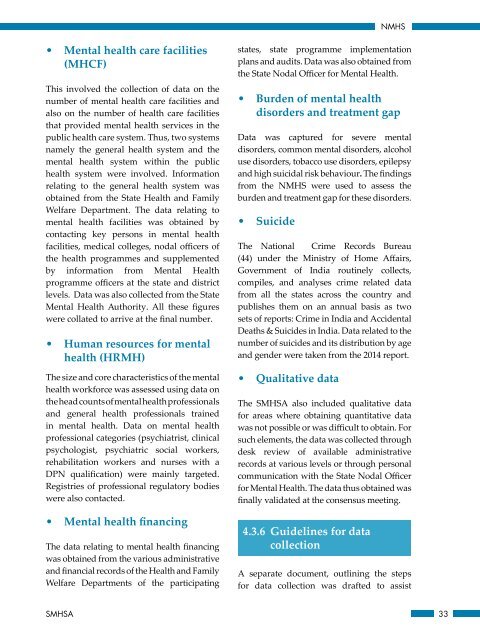National Mental Health Survey of India 2015-16
NMHS%20Report%20%28Mental%20Health%20Systems%29%201
NMHS%20Report%20%28Mental%20Health%20Systems%29%201
Create successful ePaper yourself
Turn your PDF publications into a flip-book with our unique Google optimized e-Paper software.
NMHS<br />
• <strong>Mental</strong> health care facilities<br />
(MHCF)<br />
This involved the collection <strong>of</strong> data on the<br />
number <strong>of</strong> mental health care facilities and<br />
also on the number <strong>of</strong> health care facilities<br />
that provided mental health services in the<br />
public health care system. Thus, two systems<br />
namely the general health system and the<br />
mental health system within the public<br />
health system were involved. Information<br />
relating to the general health system was<br />
obtained from the State <strong>Health</strong> and Family<br />
Welfare Department. The data relating to<br />
mental health facilities was obtained by<br />
contacting key persons in mental health<br />
facilities, medical colleges, nodal <strong>of</strong>ficers <strong>of</strong><br />
the health programmes and supplemented<br />
by information from <strong>Mental</strong> <strong>Health</strong><br />
programme <strong>of</strong>ficers at the state and district<br />
levels. Data was also collected from the State<br />
<strong>Mental</strong> <strong>Health</strong> Authority. All these figures<br />
were collated to arrive at the final number.<br />
• Human resources for mental<br />
health (HRMH)<br />
The size and core characteristics <strong>of</strong> the mental<br />
health workforce was assessed using data on<br />
the head counts <strong>of</strong> mental health pr<strong>of</strong>essionals<br />
and general health pr<strong>of</strong>essionals trained<br />
in mental health. Data on mental health<br />
pr<strong>of</strong>essional categories (psychiatrist, clinical<br />
psychologist, psychiatric social workers,<br />
rehabilitation workers and nurses with a<br />
DPN qualification) were mainly targeted.<br />
Registries <strong>of</strong> pr<strong>of</strong>essional regulatory bodies<br />
were also contacted.<br />
• <strong>Mental</strong> health financing<br />
The data relating to mental health financing<br />
was obtained from the various administrative<br />
and financial records <strong>of</strong> the <strong>Health</strong> and Family<br />
Welfare Departments <strong>of</strong> the participating<br />
states, state programme implementation<br />
plans and audits. Data was also obtained from<br />
the State Nodal Officer for <strong>Mental</strong> <strong>Health</strong>.<br />
• Burden <strong>of</strong> mental health<br />
disorders and treatment gap<br />
Data was captured for severe mental<br />
disorders, common mental disorders, alcohol<br />
use disorders, tobacco use disorders, epilepsy<br />
and high suicidal risk behaviour. The findings<br />
from the NMHS were used to assess the<br />
burden and treatment gap for these disorders.<br />
• Suicide<br />
The <strong>National</strong> Crime Records Bureau<br />
(44) under the Ministry <strong>of</strong> Home Affairs,<br />
Government <strong>of</strong> <strong>India</strong> routinely collects,<br />
compiles, and analyses crime related data<br />
from all the states across the country and<br />
publishes them on an annual basis as two<br />
sets <strong>of</strong> reports: Crime in <strong>India</strong> and Accidental<br />
Deaths & Suicides in <strong>India</strong>. Data related to the<br />
number <strong>of</strong> suicides and its distribution by age<br />
and gender were taken from the 2014 report.<br />
• Qualitative data<br />
The SMHSA also included qualitative data<br />
for areas where obtaining quantitative data<br />
was not possible or was difficult to obtain. For<br />
such elements, the data was collected through<br />
desk review <strong>of</strong> available administrative<br />
records at various levels or through personal<br />
communication with the State Nodal Officer<br />
for <strong>Mental</strong> <strong>Health</strong>. The data thus obtained was<br />
finally validated at the consensus meeting.<br />
4.3.6 Guidelines for data<br />
collection<br />
A separate document, outlining the steps<br />
for data collection was drafted to assist<br />
SMHSA<br />
33


